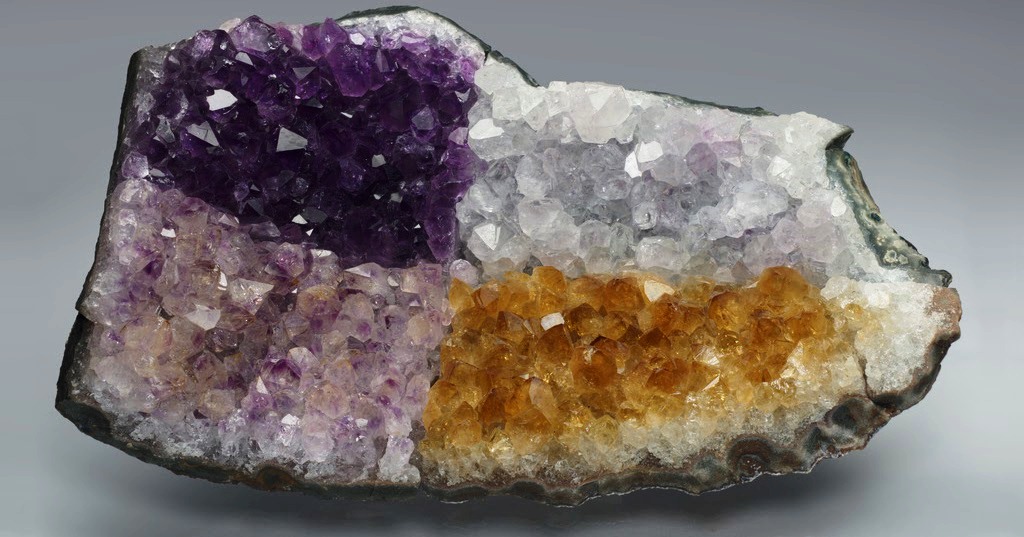

Īn amethyst geode that formed when large crystals grew in open spaces inside the rock Lesser amounts are found in many other locations in Africa, Brazil, Spain, Argentina, Russia, Afghanistan, South Korea, Mexico, and the United States. Between 20, the greatest production was from Marabá and Pau d'Arco, Pará, and the Paraná Basin, Rio Grande do Sul, Brazil Sandoval, Santa Cruz, Bolivia Artigas, Uruguay Kalomo, Zambia and Thunder Bay, Ontario. It does not fluoresce under either short-wave or long-wave UV light.Īmethyst is found in many locations around the world. When partially heated, amethyst can result in ametrine.Īmethyst can fade in tone if overexposed to light sources, and can be artificially darkened with adequate irradiation. Natural amethyst is dichroic in reddish violet and bluish violet, but when heated, turns yellow-orange, yellow-brown, or dark brownish and may resemble citrine, but loses its dichroism, unlike genuine citrine. The color of amethyst has been demonstrated to result from substitution by irradiation of trivalent iron (Fe 3+) for silicon in the structure, in the presence of trace elements of large ionic radius, and to a certain extent, the amethyst color can naturally result from displacement of transition elements even if the iron concentration is low. The uncut gem may have only a small portion that is suitable for faceting. Sometimes, only a thin layer of a natural, uncut amethyst is violet colored, or the color is very uneven. One of a gem cutter’s tasks is to make a finished product with even color. Other names for green quartz are vermarine or lime citrine.Īmethyst frequently shows color zoning, with the most intense color typically found at the crystal terminations.

Green quartz is sometimes incorrectly called green amethyst this is a misnomer and not an appropriate name for the material, as the proper terminology is prasiolite. These pale colors were once considered undesirable, but have recently become popular due to intensive marketing. "Rose de France" is defined by its markedly light shade of the purple, reminiscent of a lavender/ lilac shade. The ideal grade, called "Deep Siberian", has a primary purple hue of around 75–80%, with 15–20% blue and (depending on the light source) red secondary hues. High-quality amethyst can be found in Siberia, Sri Lanka, Brazil, Uruguay, and the Far East. Amethyst may exhibit one or both secondary hues, red and blue. The hardness of the mineral is the same as quartz, thus making it suitable for use in jewelry.Īmethyst occurs in primary hues from a light lavender or pale violet to a deep purple. Ancient Greeks wore amethyst and carved drinking vessels from it in the belief that it would prevent intoxication.Īmethyst, a semiprecious stone, is often used in jewelry.Īmethyst is a purple variety of quartz (SiO 2) and owes its violet color to irradiation, impurities of iron and in some cases other transition metals, and the presence of other trace elements, which result in complex crystal lattice substitutions. The name comes from the Koine Greek αμέθυστος amethystos from α- a-, "not" and μεθύσκω ( Ancient Greek) methysko / μεθώ metho ( Modern Greek), "intoxicate", a reference to the belief that the stone protected its owner from drunkenness. Guards against psychic attack protecting the wearer from all types of harm, including electromagnetic stress.Īlleviates sadness and grief, and dissolves negativity.6-sided prism ending in 6-sided pyramid (typical)Ģ.65 constant variable in impure varietiesĪmethyst is a violet variety of quartz. To have strong healing and cleansing powers.Ĭalm and stimulate the mind, helping you become more focused, enhancing memory and improving motivation. This stone still possesses the healing properties of amethyst but as it’s no longer purple, it will now have the healing properties associated with the colour yellow. Heat treatment does not affect a stone’s healing properties except for its use in color therapy will change. Heating mimics what the Earth does by “creating” citrine in a lab.

Heated Citrine is when a piece of amethyst is heated up in a kiln, therefore it is not “natural” Citrine. 1 piece chosen at random, intuitively selected


 0 kommentar(er)
0 kommentar(er)
